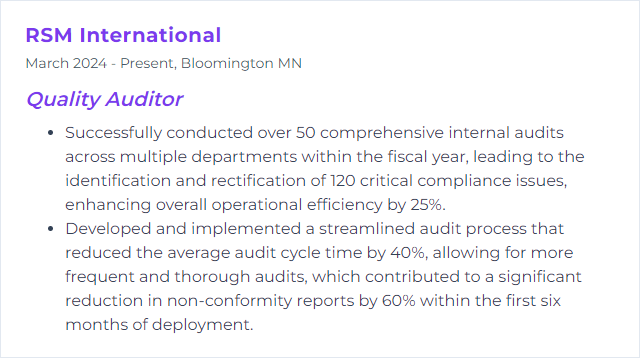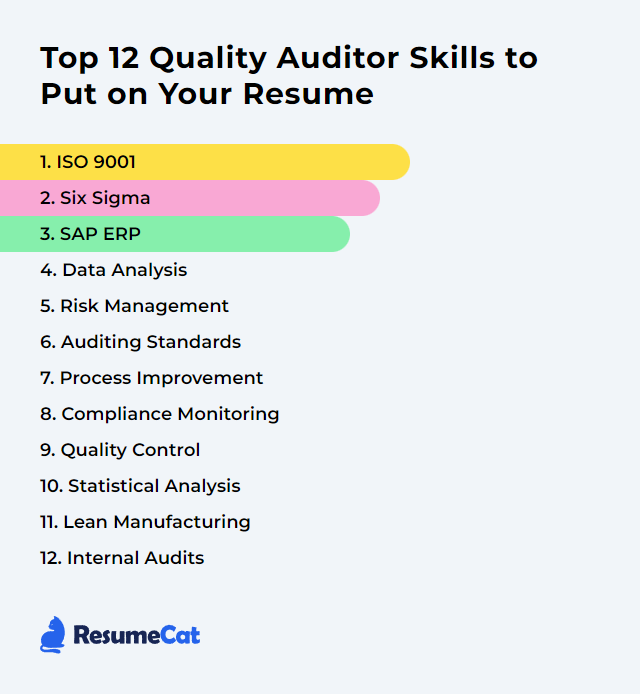Top 12 Quality Auditor Skills to Put on Your Resume
In a crowded job market, a sharp mix of quality auditing skills doesn’t just look good on a resume—it signals you can keep systems honest, processes tight, and improvement moving. The right capabilities show you can test assumptions, verify controls, and turn findings into action that sticks.
Quality Auditor Skills
- ISO 9001
- Six Sigma
- SAP ERP
- Data Analysis
- Risk Management
- Auditing Standards
- Process Improvement
- Compliance Monitoring
- Quality Control
- Statistical Analysis
- Lean Manufacturing
- Internal Audits
1. ISO 9001
ISO 9001 sets the requirements for a quality management system. It gives organizations a disciplined way to meet customer and regulatory needs, repeatably and predictably. For a Quality Auditor, it’s the yardstick and the map.
Why It's Important
It provides a common language for quality, anchors process discipline, and drives customer focus. Audits align to its clauses, so conformance—and meaningful improvement—can be judged consistently.
How to Improve ISO 9001 Skills
Run risk-based internal audits: Plan audits on process performance and risk, not just schedules. Use ISO 19011 guidance to build competence, sampling depth, and objectivity.
Strengthen management review: Make Clause 9.3 living, not ritual. Bring trend data, risks, objectives, audit results, and customer feedback that trigger decisions.
Build competence: Map skills to roles. Close gaps with targeted training, coaching, and qualification checks. Reassess after changes.
Tune processes: Map value streams, remove friction, standardize work. Blend Lean and Six Sigma to reduce variation and rework.
Listen to customers: Capture complaints, NPS, returns, and service metrics. Clause 9.1.2 expects it—act on the signals.
Manage risks and opportunities: Embed practical risk thinking in planning and change control. Keep it lightweight but real.
Control suppliers: Qualify, monitor, and audit suppliers. Tie incoming quality to supplier scorecards and corrective action.
Drive continual improvement: Clause 10 is the engine. Treat findings as hypotheses, test countermeasures, verify effectiveness, and standardize the wins.
How to Display ISO 9001 Skills on Your Resume
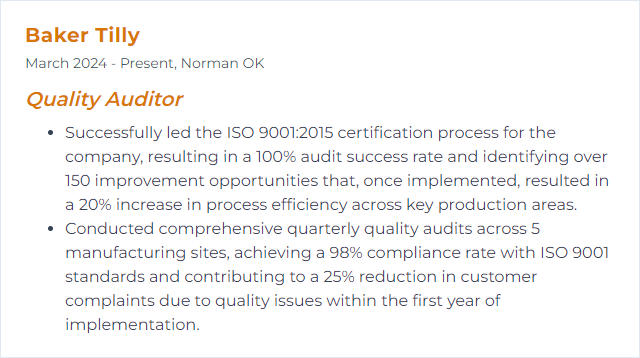
2. Six Sigma
Six Sigma is a data-first method for cutting defects and variation. It pairs statistical thinking with disciplined project execution to improve processes end to end.
Why It's Important
Auditors who grasp Six Sigma can interrogate data, test causes, and validate control plans. That means fewer opinions, more evidence, and better outcomes.
How to Improve Six Sigma Skills
Work the DMAIC structure: Define the problem crisply, measure what matters, analyze root causes, improve with trials, and lock in control. No skipping steps.
Master core tools: SIPOC, CTQ trees, Pareto, regression, hypothesis tests, control charts, capability (Cp/Cpk/Ppk), FMEA.
Apply in the wild: Run small projects tied to real metrics—yield, cycle time, scrap, complaints. Prove the lift.
Leverage software: Excel, Minitab, R/Python for analytics; process maps and FMEA platforms for collaboration.
Grow soft skills: Facilitate teams, negotiate scope, and communicate results with clarity. The math won’t land without influence.
Earn and maintain belts: Yellow, Green, Black—keep skills current with projects and mentoring.
How to Display Six Sigma Skills on Your Resume
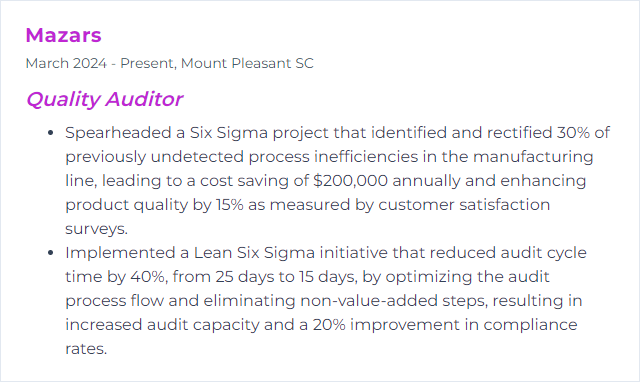
3. SAP ERP
SAP ERP (including SAP S/4HANA and legacy ECC) integrates finance, supply chain, manufacturing, sales, and more. For quality auditors, the SAP QM module ties it together—specifications, inspections, results, nonconformances, and CAPA with traceability.
Why It's Important
It centralizes quality data and process controls, enabling consistent execution, faster investigations, and airtight audit trails.
How to Improve SAP ERP Skills
Focus on QM fundamentals: Inspection plans, MICs, sampling procedures, usage decisions, notifications, and vendor/customer integration.
Tighten integration: Connect QM with MM, PP, SD, EWM, and external MES/LIMS where relevant. Broken handoffs cause escapes.
Standardize master data: Robust material masters, characteristics, and version control. Bad masters = bad outcomes.
Automate controls: Status management, workflows, and release strategies that prevent bypass and enforce review.
Report what counts: Build dashboards for complaints, yield, defect rates, and supplier performance. Use them in management review.
Train by role: Planners, inspectors, engineers, and approvers need tailored scenarios, not generic slides.
How to Display SAP ERP Skills on Your Resume

4. Data Analysis
Data analysis is the disciplined review of numbers to spot trends, outliers, and signals. It turns scattered metrics into decisions that hold up.
Why It's Important
Auditors use it to verify claims, quantify risk, and separate noise from real problems. With facts in hand, recommendations carry weight.
How to Improve Data Analysis Skills
Build statistical fluency: Distributions, sampling, confidence intervals, SPC, capability, regression.
Level up tools: Excel for speed; Minitab, R, or Python for depth. Version your work and annotate assumptions.
Visualize to persuade: Clear charts beat dense tables. Use Power BI or Tableau to surface patterns fast.
Harden data quality: Define sources, controls, and validation rules. Garbage in, chaos out.
Think critically: Challenge causal claims. Look for confounders. Run sensitivity checks.
Peer review: Fresh eyes catch leaps in logic and flaky assumptions.
How to Display Data Analysis Skills on Your Resume
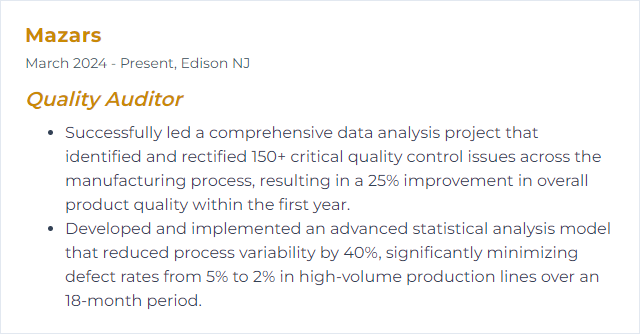
5. Risk Management
Risk management means spotting what could go wrong, sizing it up, and putting controls in place to keep outcomes within bounds.
Why It's Important
It prevents surprises. It also guides where to spend effort—on the biggest threats to quality, safety, and compliance.
How to Improve Risk Management Skills
Identify risks broadly: Processes, suppliers, tech, people, environment, change. Use checklists and workshops.
Assess with structure: Apply FMEA, risk matrices, or bowtie analysis. Consider detection, occurrence, and severity.
Design pragmatic controls: Preventive first (poka‑yoke, standards, training), then detective (alarms, checks), and responsive (CAPA).
Monitor continuously: KPIs, control charts, layered audits. Escalate when thresholds trip.
Document and communicate: Clear rationales, owners, timelines. Decisions should be traceable.
Review after change: New products, suppliers, or software? Reassess risk. Always.
How to Display Risk Management Skills on Your Resume

6. Auditing Standards
Auditing standards set the rules of engagement—planning, evidence, competence, impartiality—so audits are credible and repeatable. Think ISO 19011 for management systems and the IIA’s framework for internal audit discipline.
Why It's Important
Standards protect independence and quality. They also align practices across teams and sites, which makes findings comparable.
How to Improve Auditing Standards Skills
Study and apply the guidance: Scope, criteria, sampling, interviews, reporting. Practice until it’s muscle memory.
Use technology wisely: Audit management tools, evidence repositories, and analytics to focus effort where risk spikes.
Engage stakeholders: Set expectations early, communicate calmly, and close the loop with actionable reports.
Guard ethics and independence: Avoid conflicts, declare impairments, and keep conclusions evidence-based.
Calibrate the team: Joint audits, peer reviews, and periodic method checks to keep consistency tight.
How to Display Auditing Standards Skills on Your Resume

7. Process Improvement
Process improvement sharpens how work flows. Less waste, fewer errors, faster cycle times—without losing control.
Why It's Important
Auditors who can spot friction and propose fixes turn findings into performance gains. That’s where credibility grows.
How to Improve Process Improvement Skills
Map value streams: See the whole. Find queues, rework loops, and handoff failures.
Go to gemba: Watch the work. Ask why. Observe variation at the source.
Do root cause right: 5 Whys, fishbone, fault tree. Validate causes with data, not belief.
Run small experiments: Pilot countermeasures, measure impact, then standardize and train.
Build visual management: Scoreboards, andons, and clear standards to keep drift in check.
Benchmark smartly: Compare processes to peers and leaders; steal good ideas shamelessly.
How to Display Process Improvement Skills on Your Resume
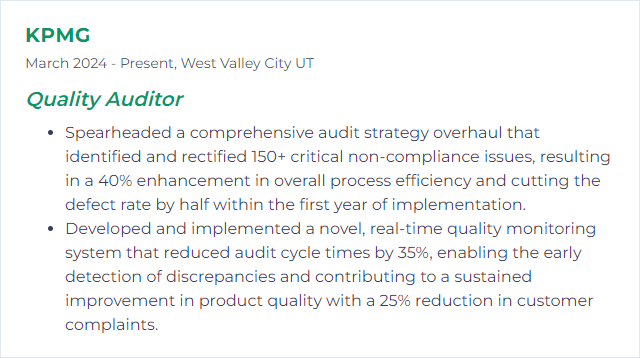
8. Compliance Monitoring
Compliance monitoring checks that operations follow rules—regulatory, customer, and internal. Quiet when it’s working, loud when it’s not.
Why It's Important
It reduces legal exposure, protects customers and brand, and gives leadership confidence that controls are not imaginary.
How to Improve Compliance Monitoring Skills
Adopt risk-based coverage: Focus testing where impact and likelihood run high.
Automate where possible: Scheduling, reminders, sample pulls, and dashboards to catch drift early.
Keep a living controls inventory: Owners, frequency, evidence needed, and escalation paths.
Use analytics: Trend exceptions, near misses, and repeat findings. Predict hotspots.
Train continuously: Regulations move; so should awareness. Short refreshers beat annual marathons.
Engage the business: Partner with process owners so fixes are built-in, not bolted on.
How to Display Compliance Monitoring Skills on Your Resume
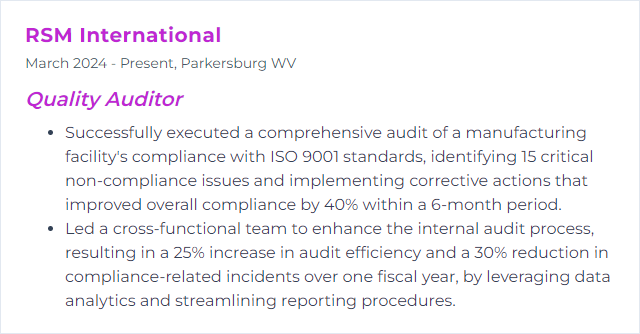
9. Quality Control
Quality Control verifies that outputs meet requirements. Inspections, tests, records—proof that the product is right, not just believed to be.
Why It's Important
It curbs escapes, lowers scrap, and protects customers. For auditors, it’s the frontline signal of process capability and discipline.
How to Improve Quality Control Skills
Clarify standards: Specifications, sampling plans, and acceptance criteria must be unambiguous and current.
Embed SPC: Use control charts and reaction plans. Treat signals quickly.
Validate measurement systems: Gauge R&R, calibration, and operator technique. Trust your data or fix it.
Strengthen control plans: Link CTQs to controls, with clear detection/response. Keep them refreshed after changes.
Close the loop: Nonconformances trigger root cause, corrective action, and effectiveness checks—not paperwork only.
Layered process audits: Supervisors to leaders verify standards on the floor. Short, frequent, powerful.
How to Display Quality Control Skills on Your Resume
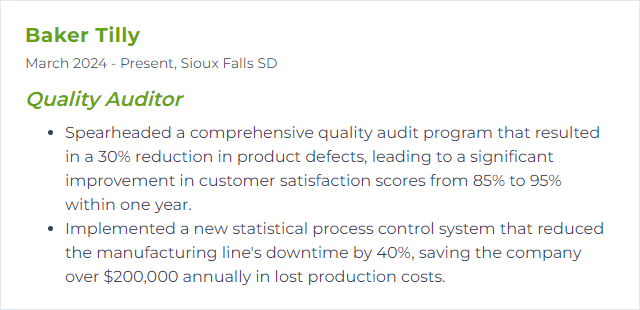
10. Statistical Analysis
Statistical analysis is the toolkit for understanding variation and risk. It keeps you honest about what the data actually says.
Why It's Important
It underpins decisions on capability, stability, and improvement. Without it, you’re guessing with spreadsheets.
How to Improve Statistical Analysis Skills
Tighten data integrity: Clear definitions, controlled sources, and verification steps before analysis starts.
Go deep on methods: Control charts, DOE, regression, ANOVA, chi‑square, nonparametrics, and capability analysis.
Use the right tools: Minitab for QC staples; R/Python for advanced modeling; Excel for quick cuts.
Practice on real problems: Apply methods to yield, complaints, downtime, and defect data. Learn by doing.
Review and challenge: Peer checks to surface bias, miscoding, or shaky assumptions.
Explain simply: Translate stats into operational risk and dollars. Make it actionable.
How to Display Statistical Analysis Skills on Your Resume

11. Lean Manufacturing
Lean Manufacturing trims waste and boosts flow. Build value, cut clutter, keep quality steady under pressure.
Why It's Important
Less waste equals lower cost and faster delivery. Better flow means fewer defects. Auditors use lean principles to judge process health.
How to Improve Lean Manufacturing Skills
Implement 5S: Sort, set in order, shine, standardize, sustain. Stable workspaces, fewer mistakes.
Value stream map: Expose bottlenecks and non‑value steps. Redesign for pull and shorter lead times.
Use Kanban and pull: Match production to demand, limit WIP, and expose issues early.
Reduce changeover: Apply SMED to shrink setup times and increase flexibility.
Build mistake-proofing: Poka‑yoke devices and controls to prevent defects rather than detect them late.
Measure what matters: OEE, first‑pass yield, lead time, and schedule adherence. Improve, then hold the gains.
How to Display Lean Manufacturing Skills on Your Resume
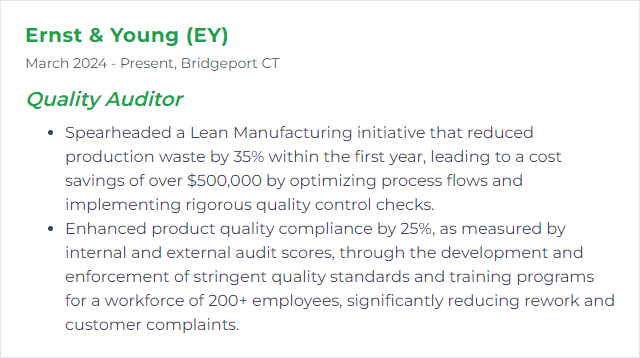
12. Internal Audits
Internal audits are structured checks run by the organization itself. They test whether processes work as intended and where they falter.
Why It's Important
They verify compliance, expose blind spots, and feed continuous improvement. Done well, they prevent external audit pain.
How to Improve Internal Audits Skills
Plan by risk: Prioritize processes with high impact, change, or bad trends. Rotate deep dives.
Prepare sharply: Clear scope, criteria, sampling, and interview plans. No fishing expeditions.
Collect strong evidence: Records, observations, and corroborated interviews. Trace samples from requirement to result.
Report with precision: State the requirement, the condition, objective evidence, and the risk. Avoid vague language.
Verify CAPA effectiveness: Not just closed, but controlled—sustained results, updated standards, trained people.
Maintain independence: Avoid auditing your own work. Rotate auditors and calibrate judgments.
How to Display Internal Audits Skills on Your Resume
